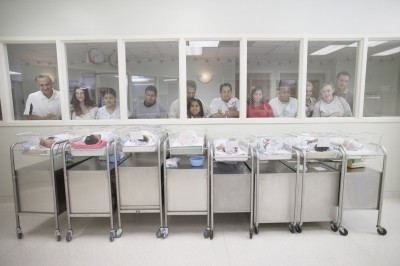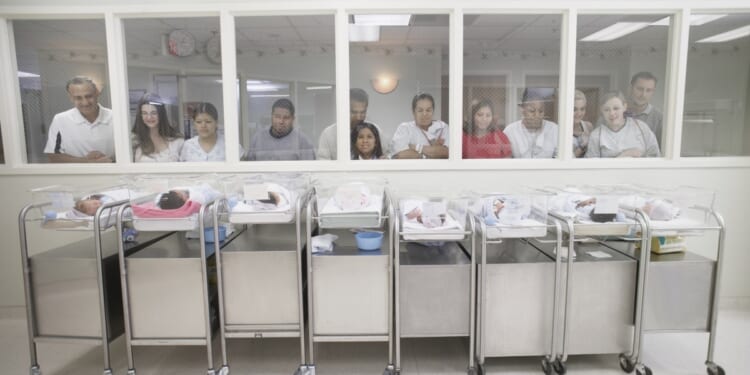
A few decades back, a Wall Street Journal editor named James Taranto posited what he called “the Roe Effect.” The idea was spawned by data showing a correlation between a woman’s political views and her views and actions regarding abortion.
Taranto argued that, over time, conservative women and families would have more children and liberal woman, accepting abortion, would have a lower birth rate, and this would lead to diminishing popular support for legal abortion.
Writing in 2005, Taranto said, “The Roe Effect … refers specifically to the nexus between the practice of abortion and the politics of abortion. It seems self-evident that pro-choice women are more likely to have abortions than pro-life ones, and common sense suggests that children tend to gravitate toward their parents’ values. This would seem to ensure that Americans born after Roe v. Wade have a greater propensity to vote for the pro-life party — that is, Republican — than they otherwise would have.”
Taranto believed that this differential was real, and his analysis of electoral data from that period supported a Republican advantage. But he also believed that even if this population trend led to a more pro-life nation, the result would be a reversal of Roe v. Wade that would force both major political parties to moderate their messages and pursue policies at the state level, avoiding the national stage and resuming the “status quo ante Roe.”
Taranto’s writing proved prescient, and as of 2022, the national abortion right was ended in the Dobbs ruling. National political players in both parties, meanwhile, while not completely avoiding the topic, have largely adopted a states’ rights perspective that de-emphasizes national debate and votes in the Congress. With the strongest messages on both sides muted, Taranto wrote, both Roe and the Roe Effect contained “the seeds of their own demise.”
Where does such an analysis stand now? The politics of childbearing may be less intense at the national level, but it would be a mistake to classify it as moderating or depolarizing. There are many reasons for this, and the implications of each are not completely clear. A new reality that has emerged is global in scope: a worldwide collapse in birth rates that has affected nations irrespective of their overall economic well-being and political character. The decline does have partisan dimensions in the United States, as discussed below, but it is happening across the board politically to at least some degree. Second, the devolution of lawmaking to the states has not produced any significant middle ground to date, with a dozen or more states withdrawing any and all legal protection for the unborn. Third, abortion has remained a national issue but one of a very different sort, fed by drugs whose distribution has proved difficult for states and localities to stop — and that the current Republican administration has so far been loath to stanch.
Nonetheless, a new kind of “Roe Effect” has appeared, and it is touching not just abortion practice but the very foundations of family formation and childbearing. A new review released by the Institute for Family Studies in September provides some astonishing facts that follow the outlines of the Roe Effect in this new dimension. Authors Scott Yenor and Lyman Stone looked at birth rate data from 2024 and found that counties that voted for Donald Trump last year have a significantly higher birth rate than counties that voted for Kamala Harris, confirming the results of a previous study. The 20 U.S. counties with the largest margins for Trump had an average total fertility rate of 1.76; the 20 counties with the highest margin for Harris had a TFR of 1.37 in 2024. Yenor and Stone infer, “Democrats increasingly seem to be the party of single women and the childless. Republicans, by contrast, are increasingly the party of those who value marriage and children.” The authors assert this trend is occurring worldwide.
Note that both of these rates are under replacement level, as, of course, is the United States as a whole. As for the reasons for the differential by political philosophy, the authors cite attitudes toward marriage and a higher desired family size as the headwaters of difference. Democrats, therefore, might look to their current political situation as more a matter of “No Rings” as “No Kings.” Meanwhile, other data on political affiliation and having an abortion show that differences among women by party affiliation are relatively small, while differences by race and income remain large. A survey released by the strongly pro-choice Kaiser Family Foundation (KFF) found that, overall, one in seven U.S. women aged 18 to 49 have had an abortion. This includes 12% of Republican women, 15% of Independents, and 14% of Democrats. By race, 21% of black women and 19% of Hispanic women have had an abortion, while 11% each of white and Asian/Pacific Islander women have had abortions. Abortion rates were four percentage points higher among lower-income women.
Data differences like these can spark some less-than-flattering speculation and advocacy, at least if X is any standard. Conservatives might be tempted to applaud lower birth rates among progressive women. Critics might question the decision of life-affirming pregnancy help organizations to support and encourage women to carry their babies to term on the grounds that they thereby only build single-parent households and later support for legal abortion. Around the world, political actors, especially some embroiled in religious conflicts, harass their opponents and wield their willingness to have more children as a weapon. A recent video from India offers a particularly ugly example.
Altogether, these international trends are worrisome at all levels — economic, social, political, and most important of all, familial. The portents continue to increase. In 2024, Japan, which has now elected a conservative prime minister, saw its population decline by more than 900,000 people. Its new president would rather see population decline than relaxed immigration laws. The United Kingdom, with a total fertility rate just below that of the United States (1.56 children per woman compared to 1.62), is debating the removal of any vestiges of public policy that protect children in the womb. The Pennsylvania House Judiciary Committee just this Tuesday passed a measure to expand and protect legal abortion to birth.
Meanwhile, Poland, a Catholic nation with a TFR of just 1.16 births per woman, is exploring income tax relief for any family that has two or more children. But Russia, with nine time zones of territory and a TFR 30% below replacement, is laying waste to its youthful generation by waging an offensive war on its neighbors in Ukraine. In the meantime, pleas continue for major expansion of child tax credits and the building of child-friendly cities in the United States, with progress in fits and starts.
The bottom line is that predicting Roe Effects, or the effects of any public policy to enhance childbearing, is a tricky business. The various distances that appear in polling on the attitudes and expectations of men and women toward one another are perhaps the most worrisome of all. Hope is the most precious possession of all, and trust in social institutions, which has been declining broadly, should follow after and reinforce the confidence that encourages families to form and endure. In the meantime, the last thing the nation needs is bitter partisanship over the value and fate of our little ones.
Originally published at The Washington Stand.
Chuck Donovan served in the Reagan White House as a senior writer and as Deputy Director of Presidential Correspondence until early 1989. He was executive vice president of Family Research Council, a senior fellow at The Heritage Foundation, and founder/president of Charlotte Lozier Institute from 2011 to 2024. He has written and spoken extensively on issues in life and family policy.

















